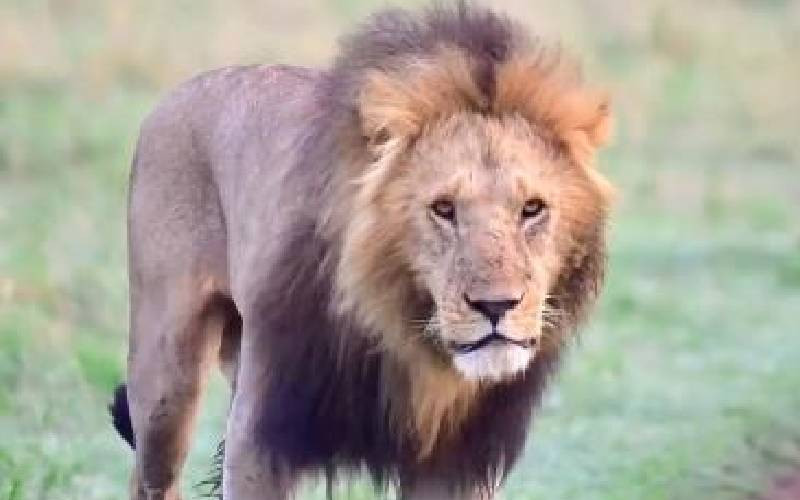Olobor Mara famous lion
The roaring of lions in the Maasai Mara could be a thing of the past if the continued killings of the lions is not stopped.
The reserves continue to suffer the loss of iconic lions raising concern on the effectiveness of the government conservation plans put in place a year ago.
Despite promises of stronger protection and management, the death of the lions underscores a deepening crisis in the reserve.
Lorkulup, a legendary lion from the Rongai Pride, and Osoipia, a dominant male lion, were both found dead in separate incidences last month and early this month.
The two lions, known for their strength and leadership, had been long-time symbols of the Maasai Mara’s wild beauty.
Lorkulup, often called the ‘best buffalo hunter’ in the Mara, had survived numerous challenges over his seven and a half years, including spear wounds, snake bites, and even buffalo charges.
His tragic death has left a deep void in the Mara’s ecosystem, where he was considered an irreplaceable figure in the pride.
The seven and a half years old whose nickname loosely translates as ‘running nose’, allegedly died after being injured during an eland hunt according to KWS and the Narok county government that manages the park reports.
His death has brought about different reactions with the Mara chief park warden Stephen Ole Minis and KWS going by the theory that since Lorkulup was found near the carcass of an eland it indicates that he took on the Eland alone and likely suffered a severe injury in the fight, making him vulnerable to hyenas.
Some also believe that hyenas finished off Lorkulup while others believe that humans were involved in Lorkulup’s death, citing evidence such as missing whiskers and claws, and a cleanly cut leg.
The lion is at the center of the debate as he was the leader of the Rongai Pride, known for his hunting skills, considered one of the greatest hunters in the Mara and most photographed in the Mara.
But his death at Maji ya fisi area which is renowned for illegal wildlife grazing, has raised more questions than answers as nobody saw the fight with the eland, lolkulup and the other poisoned lions were among the 850 to 900 lions currently at the Masai Mara National Reserve and surrounding conservancies.
However, wildlife enthusiasts, photographers, and conservationists argue that this version of events does not align with the evidence found at the scene. A viral image showing a hyena carrying a lion’s leg has fueled speculation that Lorkulup’s body was tampered with after death.
Stay informed. Subscribe to our newsletter
Renowned wildlife photographer Dr Kamalak Kannan and lion enthusiasts worldwide have raised multiple concerns regarding the circumstances surrounding Lorkulup’s demise, pointing out key discrepancies.
The enthusiasts note that Lorkulup’s remains were found far from his known territory (Kissinger Boys’ area), raising questions about how he ended up there from Maji Ya Fisi, a region notorious for human-wildlife conflict and his body was skinned, an act not associated with a natural predation event.
Conservationists strongly suspect human involvement in Lorkulup’s death.
Benson Njapit, a respected Mara tour guide, expressed deep concern about increasing human-lion conflicts in the reserve.
“As I said last year when Olobor was found dead, I’ll repeat this year when Lorkulup is gone again right at the same maji ya fisi area, where huge herds of cows graze at night….people must stop grazing cattle in the park, otherwise we’ll lose all our majestic cats,” Njapit stated.
He added that Lorkulup was well known for bringing down buffaloes and if he was never hurt or killed by a Buffalo how you can compare it with an eland antelope? The news is fake, null and void!” he posed.
The killings of the lions renew the mysterious disappearance of another famous lion, Olobor, in the Maji Ya Fisi area exactly a year ago. His fate remains unknown, but conservationists suspect that he too was killed under suspicious circumstances.
“It cannot be a coincidence that two of the most famous lions in the Mara vanished in the same place, in the same way, one year apart,” noted wildlife enthusiast Trevor Morris.
Lorkulup was beloved worldwide, with fans tracking his movements and celebrating his hunting prowess. His rare ability to bring down buffalo single-handedly was legendary, claiming that an eland was responsible for his death even more questionable.
Renowned Brazilian conservationist and lawyer, Alisson Domingues, has since filed a petition to the Kenyan Embassy in Brazil, demanding a transparent investigation into Lorkulup’s death. Inspired by this, wildlife lovers around the globe have raised similar concerns with Kenyan embassies in their respective countries.
“We are the only voices for these lions. They are being slaughtered, poisoned, and killed without accountability. The world needs to see what is happening,” declared Alisson Domingues.
The petition calls for an independent inquiry into the deaths of both Lorkulup and Olobor, along with stronger measures to protect Maasai Mara’s lions from human interference.
Lorkulup’s death the enthusiasts said marks the loss of a true warrior—a lion who had not only survived spear attacks, territorial battles, and buffalo hunts but also a venomous snake bite. He was the breadwinner of the Rongai Pride, having sired multiple cubs with his favorite lionesses.
His sudden and suspicious death they said has now left his pride in uncertainty, with serious concerns about the future survival of his cubs.
At the same time Osoipia, a male lion from the Border Pride, also met an untimely death after being involved in a livestock attack that sparked a retaliatory poisoning incident.
According to reports, the poisoning occurred on the night of February 1, when a breakaway group from the pride killed a cow near the border with Tanzania.
The poisoning, allegedly carried out by local herders in revenge, resulted in the deaths of Osoipia and several other lions, including three adult lionesses and a cub, as well as 13 hyenas. Only one male lion survived after treatment, and four other lionesses and their cubs, who did not consume the poisoned carcass, have been spotted in good health.
The deaths have shocked conservationists and wildlife lovers, who are questioning the effectiveness of the Maasai Mara Ecosystem Management Plan, launched just a year ago in 2023 to address human-wildlife conflict, poaching, and habitat loss.
The Maasai Mara Ecosystem Management Plan was designed to protect wildlife, balance human activities and wildlife, and safeguard the region’s fragile ecosystem. The plan includes measures such as habitat restoration, anti-poaching patrols, wildlife monitoring programs, and the implementation of technology.
However, despite these ambitious goals, the deaths of Osoipia and Lorkulup have raised serious questions about whether these efforts are truly effective in protecting the Mara’s wildlife.
The fact that the poisoning incident occurred just a year after the plan’s implementation has sparked outrage and disbelief among ecologists, conservationists, and tourism operators alike.
“The Maasai Mara has been promised protection and action, but the reality is that we’re still losing our iconic wildlife,”
“The conservation plan has failed to address the root causes of human-wildlife conflict, especially illegal grazing, and retaliatory killings. We need to go back to the drawing board and take more aggressive action,” said Nicolas Ole Murero, a prominent ecologist in the Mara.
Murero and other wildlife advocates argue that while the Maasai Mara management plan includes great ideas on paper, it has not been adequately implemented, and more must be done to protect the park’s wildlife from human interference. The high-profile deaths of Osopia and Lorkulup, along with ongoing illegal grazing by local communities, point to a deeper systemic failure.
One of the key failures of the Maasai Mara Ecosystem Management Plan is its inability to tackle the ongoing human-wildlife conflict, especially illegal grazing.
The Maasai Mara, surrounded by vast expanses of land inhabited by pastoral communities, has long been a battleground between wildlife conservation and human activity. Nomadic pastoralists, who rely on grazing their cattle, often encroach on wildlife corridors and the reserve itself, leading to conflicts with the animals.
“We cannot continue to blame wildlife for attacking livestock when human activity is the primary cause of conflict,” said Felix Migoya, a tour driver and guide who worked in the region for years.
While technology like the EarthRanger system has been touted as a game-changer in wildlife monitoring in the Mara after its installation last year, experts argue that it is not enough without proper enforcement of laws and policies on the ground.
EarthRanger collects real-time data from ranger patrols, remote sensors, and satellite imagery, which can alert authorities to illegal activities, but the technology is only effective when coupled with boots-on-the-ground enforcement.
“We have the technology to track wildlife and monitor illegal activity, but if we don’t have the manpower to enforce these laws, we will continue to see these tragic losses. Technology alone cannot solve the problem—it needs to be paired with stronger law enforcement and better management of the reserve,” said Elijah Sikona from the Trusted Society of Human Rights.
In the case of the poisoning incident involving Osoipia and the Border Pride, immediate action was taken by authorities, resulting in the arrest of five suspects.
However, critics argue that these arrests are not enough to stem the tide of illegal activity in the Mara. “We need more than just a few arrests. We need a comprehensive strategy that combines law enforcement, community engagement, and stronger deterrents against illegal activities,” said James Kamau, a wildlife enthusiast.
The continuing loss of iconic lions like Osoipia and Lorkulup raises serious questions about the future of Maasai Mara’s wildlife.
Despite the impressive goals of the Maasai Mara Ecosystem Management Plan, the tragic deaths of these two beloved lions highlight the plan’s inability to prevent such devastating events.
As the region grapples with the consequences of its conservation failures, wildlife experts and conservationists are calling for urgent action.
“We cannot afford to lose any more of these majestic animals,” said Njapit. “The Mara is a global treasure, and we must do more to protect it before it’s too late.”










